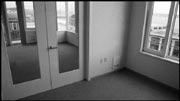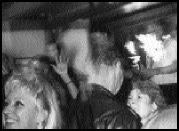THIS MIGHT BE the best time ever to move to Belltown.
Which isn’t to say that it’s exactly a great time to move to Belltown—with the average rent for a one-bedroom apartment edging above $1,500, you’ll be lucky if you can afford to sublease a closet, much less a two-bedroom split-level like the one at the just-opened Klee Lofts, which can be yours for the modest price of $5,900 a month.
But if you’re, say, a 25-to-35-year-old single professional, making in the range of $45,000 to $60,000 a year, you’ve got plenty of options. With vacancy rates higher here, at 7.3 percent, than anywhere else in the city, this onetime haven for the jeans-and-Birks tech set is suddenly a renters’ market. Leasing agents are offering bonuses like a drawing for $1,000 (at the Avalon) and free lunch (at the Wall Street Tower)—and that’s just for stopping by. Rent here, and you could get your choice of free parking, no deposit, paid utilities, or up to two months rent-free.
“Rents are not climbing because the vacancy [rate] is very high, and high vacancies mean renters have a lot of choices,” says Mike Scott, an advisor with Seattle apartment consulting firm Dupree + Scott. “When you get up to 6 or 7 percent [vacancy], the renter is king.” Leasing agents for half a dozen Belltown apartment buildings confirmed that incentives are becoming the area’s lure of last resort. Thirty-seven percent of apartment buildings now offer incentives, up from none in 1999, according to Dupree + Scott’s annual vacancy report—and some have even reduced their rents in response to the decreased demand.
At the Klee Lofts-a mix of lofts and traditional apartments with balconies, floor-to-ceiling windows, and matchless waterfront views-prospective tenants aren’t exactly busting down the doors (although Mayor Paul Schell supposedly has signed on as a tenant). But all things considered, says Klee leasing agent Rick Rodriguez, the development is doing “pretty well compared with other downtown properties,” with 20 of its 140 units already spoken for. Tenants who sign a 14-month lease at the Klee get a month’s free rent on apartments that range from a $1,025 studio to that $5,900 loft.
Elsewhere in Seattle, vacancy rates are at what Scott calls a “healthy” level: around 5 percent, a rate that balances supply and demand so that rents don’t go up too fast but units don’t sit vacant for months on end. So what happened in Belltown? Several things: First, the high-tech boom, coupled with an influx of new Seattle residents—many of them from overseas—produced tremendous demand for housing downtown. Construction permits doubled, then quadrupled, to meet the demand. Now, the high-tech boom is no more, the market is slack for high-end housing, and immigration to Seattle has slowed—just in time for hundreds of luxury units planned during the boom to open for business.
Housing consultant Scott says the kind of people who can afford $2,000 apartments just aren’t moving downtown anymore. “Clearly, up until about a year and a half ago when the high-tech boom was really strong, it was fueling the office market, and that was also fueling the housing market,” Scott says. “And so the high-tech boom that we had really did fuel a lot of this construction and the general growth in our economy.”
Meanwhile, the downtown construction glut is only compounding the problem. Scott, who notes that the number of new apartments in Belltown nearly doubled between 2000 and 2001, says the area’s dismal vacancy rate doesn’t include any of the apartments that have just started “lease up,” the period when new buildings are expected to fill with tenants. If those developments were included, Scott says, the “gross vacancy” rate would be closer to 22 percent—15 percent higher than the King County average.
That rate, though an imperfect indicator of the health of the rental market, isn’t likely to get any lower as new units enter the already saturated market. The Klee’s Rodriguez says the cranes and bulldozers that have turned Western into one long construction site are making people think twice about renting there. “People are more hesitant because our area is going through a major development right now—we’re the second building opening up within a three-block radius.”
Location, of all things, may also be affecting people’s decisions to stay out of Belltown. At the ritzy Valera near Pike Place Market, which opened this past August, agent Barbara Hartley says apartments are going fast. By early October, half the units, which cost from $1,000 to $2,300 and up, were taken—and that’s without any splashy incentives, unless you count a membership to the Seattle Athletic Club (most larger new buildings have their own fitness facilities). Hartley says the size of the building—just 43 units—and its location near the downtown business core have helped spark renters’ interest.
Finally, there’s one more economic factor that apartment planners could not have predicted: Interest rates are at a historic low, turning many longtime renters into first-time buyers. “I never thought I’d see rates like this in my career,” says Leslie Williams of Williams Marketing, who specializes in condominium sales. “More people are out looking, and they’re wanting to buy.”
No one knows when the Belltown market will turn around. What is clear is that it won’t be any time soon. More than 300 new apartment units are expected to be completed in 2002, on top of the nearly 1,200 that will be finished this year. “Nobody is glad to be opening a big luxury apartment today because it’s a bad time,” housing consultant Scott says, even though “all of these new properties, in the long run, are probably good investments.” But until something—an economic turnaround, drastic rent reductions, or irresistible incentives—convinces renters to move back to Belltown, you may want to get down to the Avalon and enter that $1,000 drawing.







